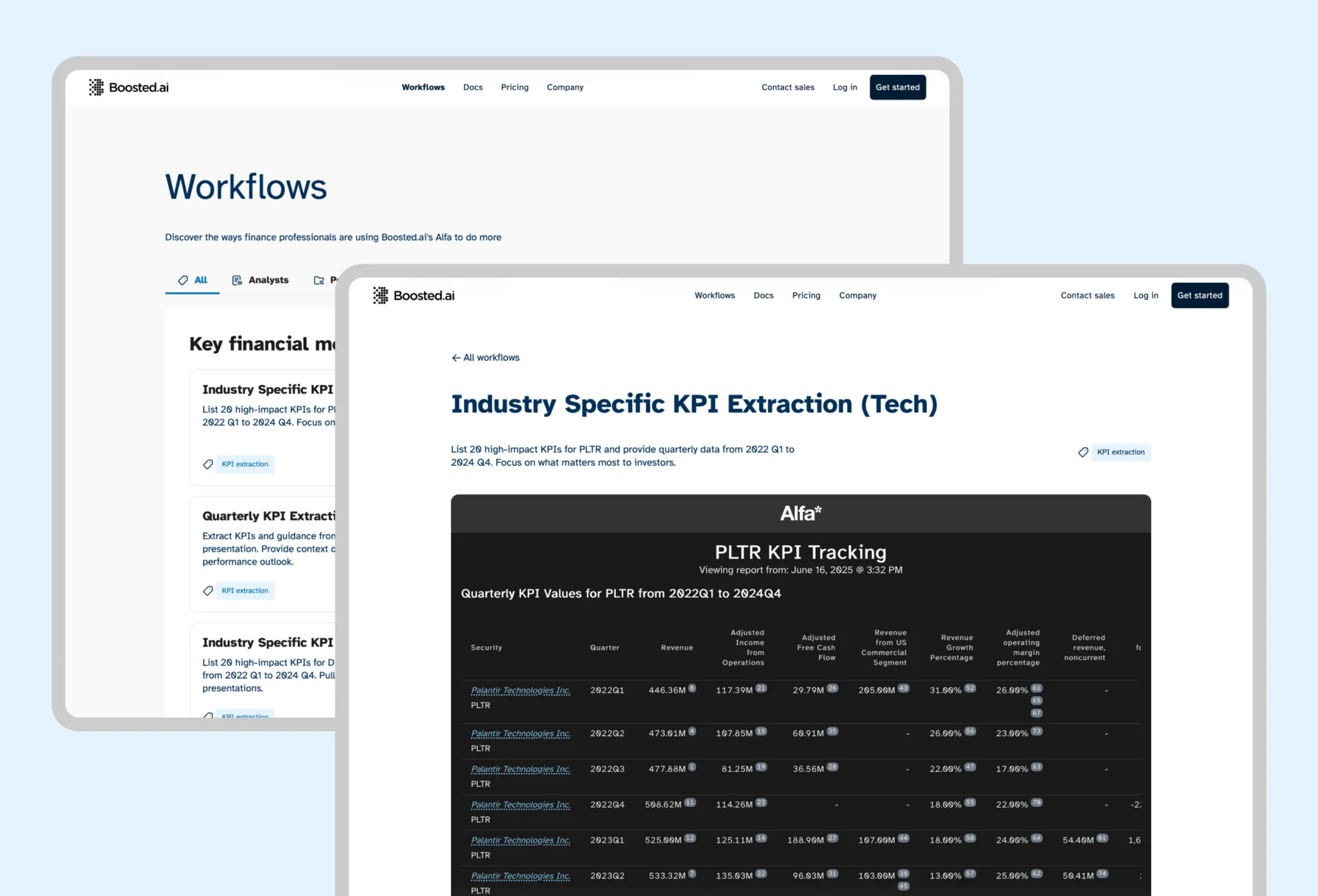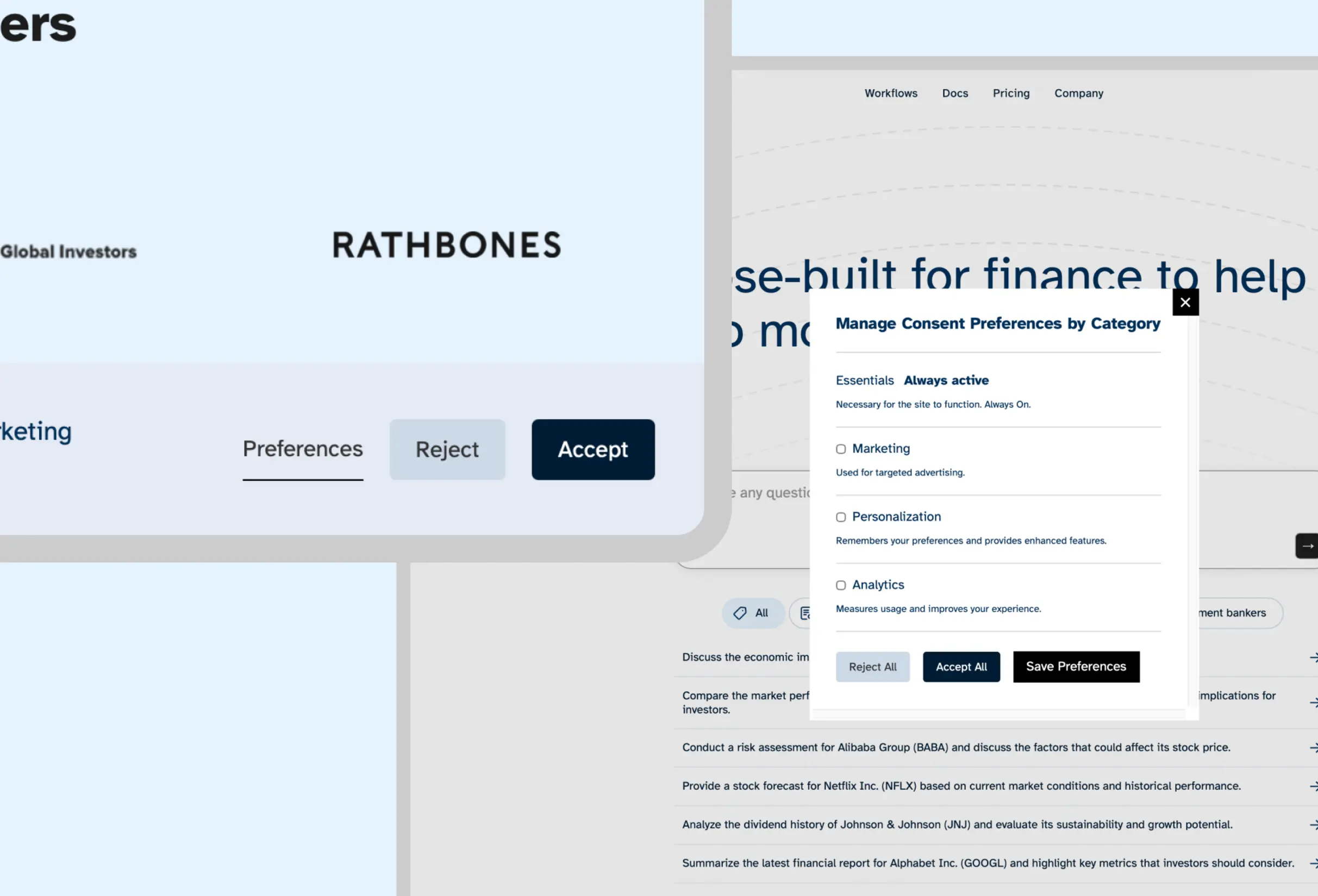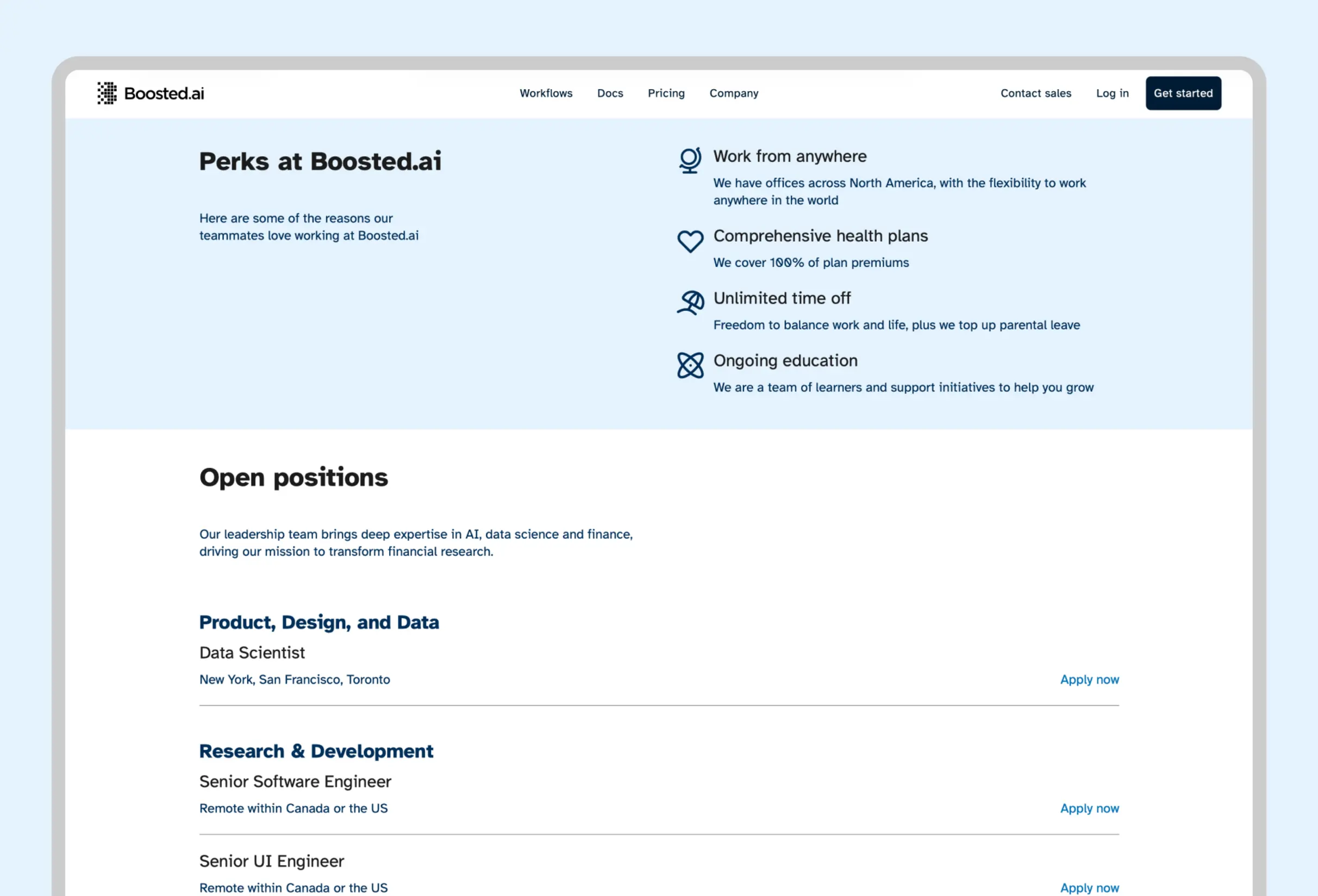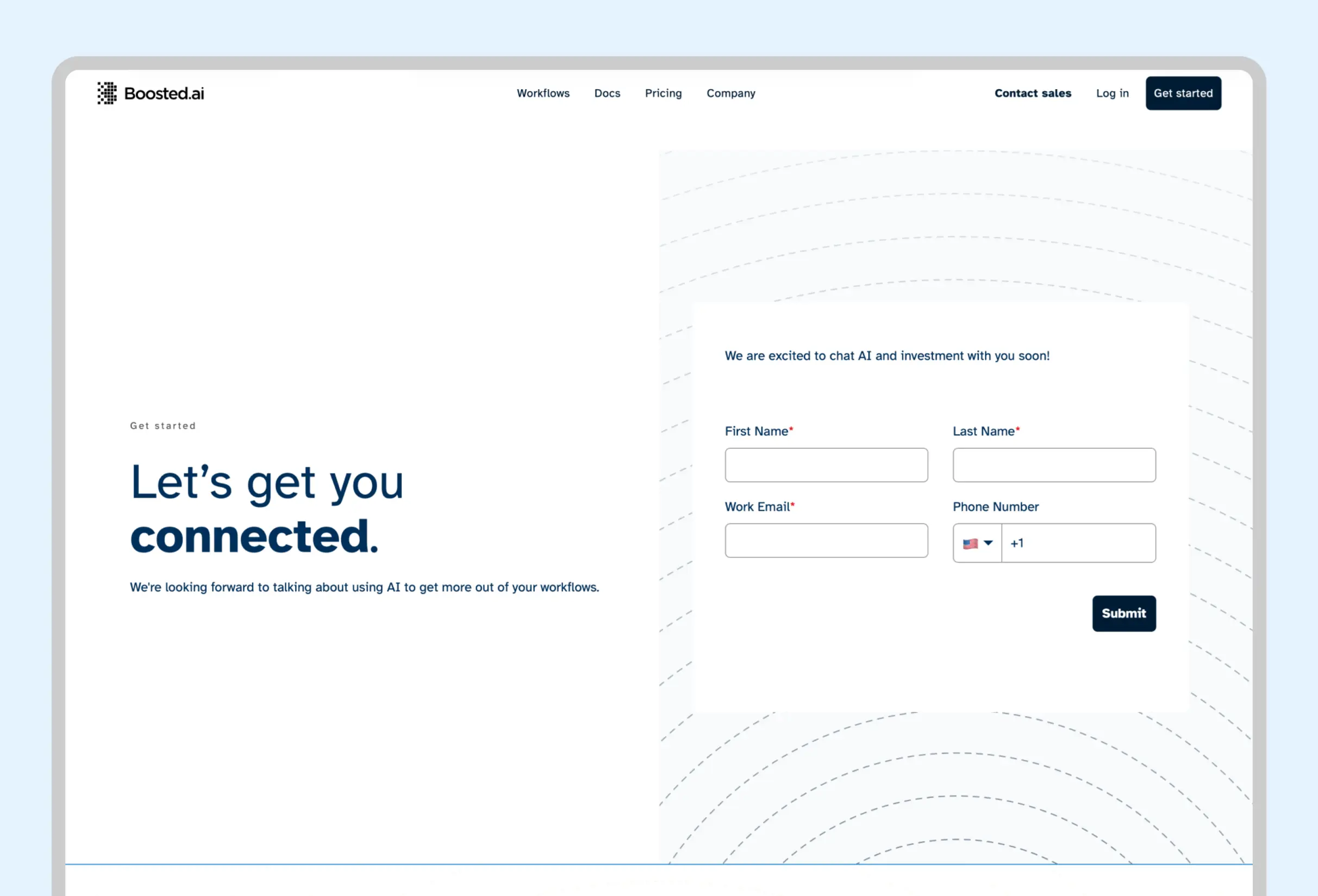
Case Study

BrandZap has been proud to be Boosted.ai’s Webflow development partner for over two years. What began as a straightforward website relaunch and migration from WordPress to Webflow has evolved into a long-term collaboration supporting continuous improvements and technical integrations across the site.
Originally designed by BrandZap as part of a broader brand initiative, the Boosted.ai website has since become a dynamic hub that adapts alongside the company’s evolving product ecosystem. As Boosted’s product and marketing teams roll out new features, reposition others, and expand their go-to-market strategy, BrandZap has ensured that the marketing website remains not only visually consistent but technically powerful and compliant.
While the website appears clean and minimal from the user’s perspective, behind the scenes it operates as a complex, analytics-driven system. These underlying layers enable Boosted’s product marketers to dynamically update content, measure engagement, and maintain consistency across campaigns—all while ensuring compliance and performance at scale.
Here are a handful of elements and features implemented by BrandZap:
The Boosted.ai homepage features a custom animated typewriter script developed by BrandZap. The animation dynamically cycles through key personas and use cases—changing only the final word of the headline to reflect different audience segments (e.g., “for Analysts,” “for Portfolio Managers,” “for Risk Teams”).
This subtle animation immediately communicates product relevance to multiple buyer personas and adds a layer of interactivity to the first impression, all while maintaining site performance and accessibility standards.


At the heart of Boosted’s AI platform is Alfa, the company’s flagship product. Alfa uses intelligent “workflows” to guide analysts through complex financial reasoning—helping them research, analyze, and produce comprehensive reports using AI and large language models.
To help prospects better understand Alfa’s capabilities, the product marketing team envisioned an interactive “Workflows” section on the website. Visitors could explore different workflows that mirrored their potential use cases, view examples, and even preview how Alfa’s AI-generated reports look and function in practice.
This posed a technical challenge: the workflows and reports typically lived within the product’s private environment. Working closely with Boosted’s product and engineering teams, BrandZap architected a solution that integrated gated access to select content within the Webflow site. The result was a highly dynamic filtering and search system that allows users to browse and filter workflows by category or topic—offering a tangible sense of the product experience while maintaining data security and product integrity.

To help communicate complex product features, BrandZap designed a set of modular diagrams that visually explain key aspects of the Boosted.ai platform. These diagrams are integrated throughout the website, each built in Figma and exported as scalable SVGs for Webflow implementation.
Each visual simplifies abstract AI and data concepts—illustrating how workflows, machine learning models, and integrations connect within the product. These diagrams serve dual purposes: improving user comprehension and reinforcing the sophistication of Boosted’s technology.
The Boosted.ai team wanted to offer a frictionless preview experience—letting users explore the product just enough to spark curiosity before requiring a login. To achieve this, BrandZap designed a soft-gate popup system that triggers naturally during exploration. When a user attempts to run a simulated AI prompt or view deeper content, they’re prompted to sign up or log in to continue. This subtle gating balances user experience with lead-generation effectiveness, turning product curiosity into measurable marketing opportunities.

To support ongoing marketing campaigns, BrandZap developed a Dynamic Resources System that unifies all forms of content—blogs, webinars, and whitepapers—under a single, filterable CMS framework. Each content type is automatically displayed through tabbed navigation and styled according to its category, ensuring a consistent visual experience while maintaining flexibility for the marketing team.
Built entirely in Webflow, the CMS includes features such as:
Comprehensive slide templates for sales, product reports, and investor decks.
Flexible layouts for case studies, data visualizations, and market narratives.
Built-in brand styling for seamless in-house use.
This system has allowed Boosted’s marketing team to efficiently scale their content library while maintaining brand consistency and technical stability.

Operating globally means adhering to complex data privacy regulations. BrandZap implemented a GDPR-compliant cookie and tracking system that prevents analytics and marketing scripts from firing until explicit user consent is given. The system also includes a secondary user settings modal where visitors can review and modify their consent preferences.
Because strict compliance can reduce lead-tracking efficiency, BrandZap worked closely with the marketing operations team to introduce non-cookie–based engagement methods—such as gated content and email-based event tracking—ensuring that data integrity and lead capture remained robust even under GDPR restrictions.

To bridge the gap between Boosted’s marketing website and its product ecosystem, BrandZap integrated Posthog Analytics for unified tracking. This system monitors user behavior across both environments—helping the team understand how visitors move from awareness (on the marketing site) to activation (within the Alfa product).
Through custom-built Posthog cohorts, the Boosted marketing team can now segment audiences by intent (for example, users exploring workflows vs. those browsing hiring pages), enabling more personalized outreach and better attribution between marketing activity and product engagement.
Boosted’s HR team was limited by Greenhouse’s default job board, which lacked branding control and lived outside of the main site’s analytics ecosystem. To resolve this, BrandZap built a custom job board integration using JavaScript to securely pull job listings from Greenhouse’s API directly into Webflow—no iframes or external redirects required.
The result is a seamlessly branded, natively styled careers page that performs well across devices, loads quickly, and allows Boosted’s analytics stack to capture applicant behavior. Each listing links to Greenhouse for final application submission, preserving the integrity of the ATS while improving the candidate experience and visual cohesion.

BrandZap also implemented a GDPR-compliant HubSpot form system that integrates directly with Boosted’s Webflow CMS. The setup enables dynamic, context-aware forms—such as lead capture on gated content or contact forms embedded within specific product pages—while ensuring all tracking and cookie behaviors align with privacy regulations. This integration allows the marketing team to capture leads efficiently without compromising user trust or compliance.

The Boosted.ai Webflow ecosystem represents the ideal intersection of marketing design, technical integration, and compliance. Through a blend of custom development, cross-platform analytics, and smart content systems, BrandZap helped transform Boosted’s marketing website into a dynamic, data-informed growth engine. What started as a migration project has become an ongoing collaboration rooted in innovation, scalability, and trust.